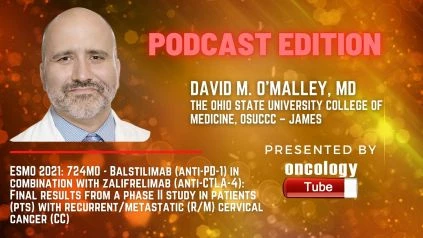David M. O’Malley, MD, Department of Obstetrics and Gynecology at The Ohio State University College of Medicine and the director of the Division of Gynecologic Oncology at the OSUCCC – James speaks about ESMO 2021 Abstract – 724MO – Balstilimab (anti-PD-1) in combination with zalifrelimab (anti-CTLA-4): Final results from a phase II study in patients (pts) with recurrent/metastatic (R/M) cervical cancer (CC).
Background:
The treatment of R/M CC in the second line remains a serious clinical issue. Multiple cancers have been successfully treated by blocking both the PD-1 and CTLA-4 immune checkpoints. We present the results of a large single-arm Phase II trial in patients with R/M CC to assess the safety and antitumor efficacy of the anti-PD-1 antibody balstilimab (bal) in combination with the anti-CTLA-4 antibody zalifrelimab (zal).
Methods:
For up to two years, pts were given bal 3 mg/kg Q2W in conjunction with zal 1 mg/kg Q6W. The primary outcome was the objective response rate (ORR) as determined by independent evaluation according to RECIST 1.1; secondary objectives were safety, DOR, and survival.
Results:
A total of 155 people were given bal plus zal (safety population). The efficacy-evaluable group consisted of 125 patients with detectable illness at baseline and one prior line of platinum-based treatment in the R/M setting, with results shown in the table below. The average study duration was 19.4 months. The combination was found to be tolerable, and no additional safety signs were discovered. Grade 3 associated AEs were detected in 33 patients (21.3%), with ALT rise (3.2%), anemia (1.9%), and diarrhea (1.9%) being the most common. In 15 points, treatment was stopped owing to a connected AE (9.7 percent ). Immune-related AEs were reported by 69 patients (44.5%) (12.6 percent grade 3); hypothyroidism (13.5%), hyperthyroidism (13.5%), and diarrhea (each 7.1 percent) were the most prevalent all-grade occurrences.
Conclusions:
In patients with previously treated R/M CC, the combination of bal and zal showed excellent response rates (including full remissions), DOR, and OS. Patients with PD-L1+ tumors saw the most clinical benefit, however activity was also found in the PD-L1- group. The therapy plan was well-received.
Clinical trial identification
NCT03495882

